Douglas DC-3 Dakota
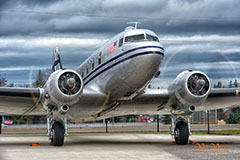 Perhaps the most iconic airliner of all time, the Douglas DC-3 brought airline travel to the masses. As the military C-47, it became the backbone of our WWII transport fleet, supplying troops and bases all around the world. After wartime service, most of the retired C-47s found work in the civilian world. Between 1946-50, eighty-five percent of airliners were DC-3s. Our DC-3 saw service in Burma, China and India as a C-47 and, when converted, throughout the Western Hemisphere as a civilian DC-3.
Perhaps the most iconic airliner of all time, the Douglas DC-3 brought airline travel to the masses. As the military C-47, it became the backbone of our WWII transport fleet, supplying troops and bases all around the world. After wartime service, most of the retired C-47s found work in the civilian world. Between 1946-50, eighty-five percent of airliners were DC-3s. Our DC-3 saw service in Burma, China and India as a C-47 and, when converted, throughout the Western Hemisphere as a civilian DC-3.
______________________
B-25D Mitchell ‘Grumpy’
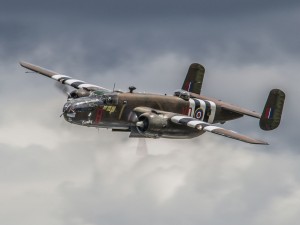 Our B-25D Mitchell Bomber is packed with military and civilian heroes, lauded and unsung. Billy Mitchell, the only American for whom a U.S. combat aircraft has been named. Jimmy Doolittle, who gave us hope after Pearl Harbor. Countless pilots and crews took on bombing missions that spanned all war theaters—in particular the South Pacific–and who also brought desperately needed planes to the European theater. Add the designers, engineers, and Rosie the Riveters who ensured the B-25 was the hardiest of planes. And finally, all the civilian owners who’ve kept the plane alive and active, most recently on a mission honoring World War II veterans.
Our B-25D Mitchell Bomber is packed with military and civilian heroes, lauded and unsung. Billy Mitchell, the only American for whom a U.S. combat aircraft has been named. Jimmy Doolittle, who gave us hope after Pearl Harbor. Countless pilots and crews took on bombing missions that spanned all war theaters—in particular the South Pacific–and who also brought desperately needed planes to the European theater. Add the designers, engineers, and Rosie the Riveters who ensured the B-25 was the hardiest of planes. And finally, all the civilian owners who’ve kept the plane alive and active, most recently on a mission honoring World War II veterans.
______________________
P-51B Mustang ‘Impatient Virgin’
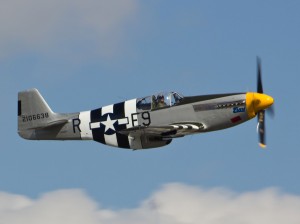 Nicknamed “their little friend” by Allied bomber crews in World War II, the P-51B Mustang emerged in 1942 as the fast, high-altitude North American fighter that could escort bombers deep into enemy territory and turn the tide of losses sustained during long-range missions. The P-51B also saw action in the Korean War and remains a favorite racer and aerobatics performer for today’s aviators. Between 1944–1945, our Impatient Virgin flew more than 700 hours for the 376th North American Fighter Squadron in England. That’s a more than exceptional record—in most cases, a P-51B flew only about 75 hours before sustaining irreparable damage. After a rather interesting crash, our plane lay scattered in a British beet field for more than a half-century, when it was rediscovered and “harvested” by extremely patient archaeologists.
Nicknamed “their little friend” by Allied bomber crews in World War II, the P-51B Mustang emerged in 1942 as the fast, high-altitude North American fighter that could escort bombers deep into enemy territory and turn the tide of losses sustained during long-range missions. The P-51B also saw action in the Korean War and remains a favorite racer and aerobatics performer for today’s aviators. Between 1944–1945, our Impatient Virgin flew more than 700 hours for the 376th North American Fighter Squadron in England. That’s a more than exceptional record—in most cases, a P-51B flew only about 75 hours before sustaining irreparable damage. After a rather interesting crash, our plane lay scattered in a British beet field for more than a half-century, when it was rediscovered and “harvested” by extremely patient archaeologists.
______________________
Spitfire Mk. IX
 One of the most important fighters ever built, the Supermarine Spitfire achieved immortality for helping win the Battle of Britain in 1940. This elegant and agile plane also played a host of roles worldwide from 1936–1957. With SL633, Kilo-7 offers a fully restored LF Mark IXe that served four air forces and snared aviation researchers in a 23-year identity search. Painted in the air force livery of Czechoslovakia, this plane pays tribute to the Czech, Polish and Hungarian pilots who joined the Royal Air Force in WWII and reestablished their own air forces after the war.
One of the most important fighters ever built, the Supermarine Spitfire achieved immortality for helping win the Battle of Britain in 1940. This elegant and agile plane also played a host of roles worldwide from 1936–1957. With SL633, Kilo-7 offers a fully restored LF Mark IXe that served four air forces and snared aviation researchers in a 23-year identity search. Painted in the air force livery of Czechoslovakia, this plane pays tribute to the Czech, Polish and Hungarian pilots who joined the Royal Air Force in WWII and reestablished their own air forces after the war.
______________________
F7F Tigercat ‘Bad Kitty’
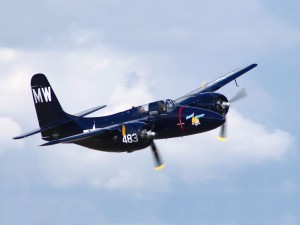 What do we all love? A come-back story. One of the fabled Grumman “cats,” the F7F-3’s flight path is about redemption–how “the best damn fighter in the world” was literally rescued from the graveyard. Though the Tigercat was originally designed as a combat carrier plane, it never saw service in WWWII. That said, this twin-engine fighter combined the power and stealth needed for ground missions in the Korean War, and also found a niche in photo reconnaissance. But it was sorely underused, and every Tigercat would have been turned into scrap metal if it weren’t for another innovation—a second career fighting forest fires. Our F7F-3, one of only 6 Tigercats still flying today, can tell the story.
What do we all love? A come-back story. One of the fabled Grumman “cats,” the F7F-3’s flight path is about redemption–how “the best damn fighter in the world” was literally rescued from the graveyard. Though the Tigercat was originally designed as a combat carrier plane, it never saw service in WWWII. That said, this twin-engine fighter combined the power and stealth needed for ground missions in the Korean War, and also found a niche in photo reconnaissance. But it was sorely underused, and every Tigercat would have been turned into scrap metal if it weren’t for another innovation—a second career fighting forest fires. Our F7F-3, one of only 6 Tigercats still flying today, can tell the story.
______________________
F8F Bearcat
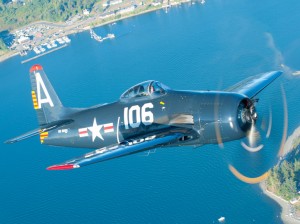 Designed to meet and beat the infamous Japanese Zero and defend Navy fleets against incoming kamikaze attacks, the Grumman Bearcat was among the last piston-engine flyers built specifically for World War II combat. As the saying goes, you didn’t strap into the Bearcat; you strapped it onto you—this little plane was all attitude and performance. No radar, no missiles: The Bearcat was a scrappy, feral fighter that could move from brake release at sea level to 10,000 feet in just 96 seconds.
Designed to meet and beat the infamous Japanese Zero and defend Navy fleets against incoming kamikaze attacks, the Grumman Bearcat was among the last piston-engine flyers built specifically for World War II combat. As the saying goes, you didn’t strap into the Bearcat; you strapped it onto you—this little plane was all attitude and performance. No radar, no missiles: The Bearcat was a scrappy, feral fighter that could move from brake release at sea level to 10,000 feet in just 96 seconds.
For better or worse, World War II hostilities ended just as the first fleet of Bearcats was en route to combat deployment, though many of the 1,200+ planes produced did see military service over the next decades. The Bearcat was the first plane used in performances by the US Navy’s Blue Angels demonstration team. Our Wampus Cat, one of 10 Bearcats still flying today, had a long, winning career in civilian air racing and demonstrations.
______________________
P-51D Mustang
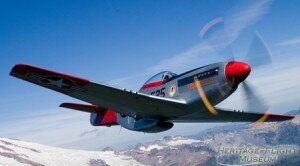 The P-51 was the “100 day wonder” of WWII. Originally specified and ordered by Great Britain, and ignored by the US Army Air Corps, the aircraft was designed and built by North American Aviation from the ground up in 100 days. When it’s capabilities were later recognized by the USAAC, it was ordered in vast quantities. The range, speed and high altitude capabilities enabled the Allied forces to escort bombers far deeper into enemy territory than any other fighter aircraft; as exemplified by the 332 Fighter Group (the Tuskegee Airmen in their ‘Red Tail’ Mustangs). This allowed the continuation and fruition of the American Bomber force’s tactic of precision daylight bombing.
The P-51 was the “100 day wonder” of WWII. Originally specified and ordered by Great Britain, and ignored by the US Army Air Corps, the aircraft was designed and built by North American Aviation from the ground up in 100 days. When it’s capabilities were later recognized by the USAAC, it was ordered in vast quantities. The range, speed and high altitude capabilities enabled the Allied forces to escort bombers far deeper into enemy territory than any other fighter aircraft; as exemplified by the 332 Fighter Group (the Tuskegee Airmen in their ‘Red Tail’ Mustangs). This allowed the continuation and fruition of the American Bomber force’s tactic of precision daylight bombing.
Built in 1945, this aircraft is believed to have served in the Texas Air Guard and with the Indonesian Air Force. Along with one other, it was returned to the US by Stephen Johnson, sold to the War Eagles Museum where it went through initial restoration. It was further restored by Pena Olivas for Bill Anders in 1995. Donated by Bill to the museum when the museum was started in 1996, ‘Val-Halla’ reflects the the colors of the 57th FIS (Fighter Interceptor Squadron), the Black Knights. This is the squadron Bill flew F-89′s with back in 1958. Bill raced this plane at Reno in 1997, ’98 and ’99 as race #68, commemorating the year Apollo 8 went to the moon. His best showing with this airplane was on a gusty race Sunday in ’97, taking third in the Unlimited Class Silver race.










